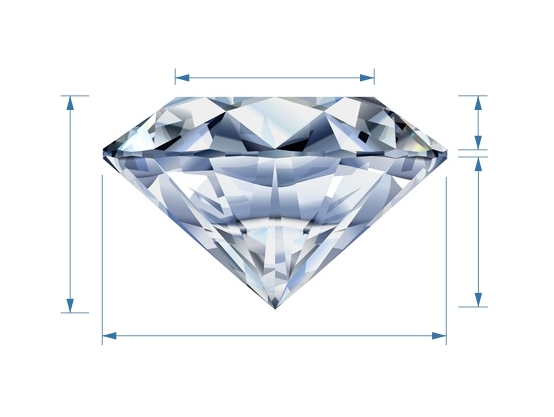When buying a pink diamond, you should first decide on its size and color intensity as these are the most important factors that will determine how much you will have to pay.
Pink diamonds owe their color to certain physical abnormalities and chemical impurities within their structure. Most of these stones come from a single place in Australia – the Argyle mine. Natural pink diamonds are among the rarest and most expensive fancy-colored stones.

Pink diamond
Evaluating the Color of Pink Diamonds
The color of a pink diamond has three main components on which it is evaluated: hue, saturation, and tone.
Hue is the visible color of a fancy-color diamond.
The primary hue of a pink diamond is, of course, pink.
However, there can be secondary hues of a different color. In general, secondary hues that enhance the primary color are deemed to add to the value of the stone, whereas ones that detract from its primary hue can diminish its worth.
Common undertones in pink diamonds are purple, brown, and orange; purple and orange are more valuable, while brown and yellow are less desirable.
Pink diamonds with no secondary coloring are rare and usually more expensive than ones with additional hues.
Saturation refers to the intensity of the stone’s color.
As a rule, the more intense the color of a diamond, the more valuable it is. Therefore, diamonds that have a deep pink color will be worth more than ones whose hue is faint.
The most expensive pink diamonds are those whose color is closest to red (by the way, natural red diamonds are the rarest colored diamonds).
Tone is a characteristic that tells you how light or dark the color of a fancy-color diamond is.
What tone you will choose comes down to your personal preference, but usually, stones that are too light or too dark to have a discernible primary color are not as sought after as those that are medium dark and have a well-defined hue.
Pink diamonds are graded using the following categories: Faint Pink, Very Light Pink, Light Pink, Fancy Light Pink, Fancy Pink, Fancy Intense Pink, Fancy Vivid Pink, Fancy Dark Pink, and Fancy Deep Pink.
If there is a secondary color, it is also included in the grade; for example, Fancy Purplish Pink describes a pink stone with a purple undertone.
Pink Diamonds and Carat Weight
In general, bigger fancy-color diamonds are rarer and therefore cost disproportionately more per carat. This trend is even more pronounced with pink diamonds, which are among the rarest colored diamonds.
So, if you are planning to buy a pink diamond bigger than 0.3-0.4 carats, be ready to pay substantially more than the price of a smaller but otherwise comparable stone.
Plan your budget accordingly, and keep in mind that pink diamonds bigger than 0.5 carats are very rare and expensive.
Evaluating the Clarity of Pink Diamonds
Although the clarity of pink diamonds is graded the same way as that of colorless stones, this characteristic is not as important for fancy-color diamonds as their flaws tend to be less visible due to the stone’s coloring.
All else being equal, pink diamonds with fewer flaws are more expensive. However, you don’t need to pay top dollar for a stone that is perfectly clean – a cheaper diamond of a lower clarity grade can look just as flawless to the naked eye.
You can find reasonably clean stones in the SI1-SI2 clarity range that don’t have inclusions visible to the unaided eye; fancy-color diamonds in the VS and VVS clarity categories tend to be more expensive but may not offer a visible difference.
Pink Diamonds and Cut
When it comes to pink diamonds (and all fancy-color diamonds for that matter), cut is not evaluated the same way as is that of colorless stones.
The reason for this is that colored diamonds are not necessarily cut with proportions that maximize brilliance and sparkle as these characteristics are deemed secondary for fancy-color stones. Instead, colored diamonds are cut to maximize color intensity.
So, don’t judge the cut of pink diamonds using traditional grades. You should look at the stone’s color first and consider brilliance only after you are satisfied with the diamond’s color saturation.
Treated and Synthetic Pink Diamonds
Since natural pink diamonds are very rare and expensive, vendors offer artificially colored stones that are more affordable.
Some pink diamonds are simply natural colorless diamonds that have been subjected to heat, pressure, and irradiation to alter their color.
There are also synthetic pink diamonds, which are created in a lab but have the same chemical structure as natural stones.
When buying a pink diamond, always make sure that the stone is accompanied by a certificate that documents whether it is natural or synthetic as well as whether the diamond has been treated to change its color.
Where to Buy Diamond Jewelry?
We recommend James Allen (read review) because you can see a 360-degree video for any diamond before buying it.
Blue Nile is another reputable diamond retailer we recommend.














